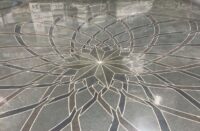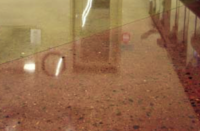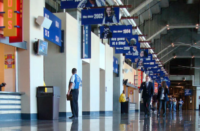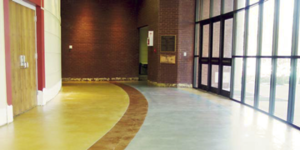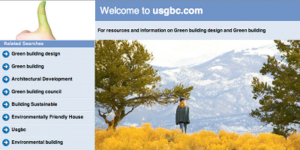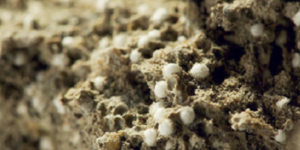Common Sense plus Dollars and Cents equals Green Sense, or so you would think.
Generally when we think of “building green,” we think of the LEED program from the U.S. Green Building Council (USGBC). LEED, which stands for Leadership in Energy and Environmental Design, is the buzzword of the day in sustainable building practices, as well it should be.
Or should it? Though its quest is noble, does it come up short in its execution? Let’s take a look at both the LEED program and how polished concrete fits the philosophy — if not the stated criteria — perfectly. If you gain nothing else, I want each of you to be proud of the product and process that you provide to your customers, and I want you to have both the knowledge and comfort level to be a cheerleader for the industry. We are “green,” and our process does make sense, both today and tomorrow, even if the existing LEED criteria leaves us on the outside looking in. Even the addition of an acid stain is only a blip on the radar, and does not prohibit a property from gaining certification if all other criteria are met. Polished concrete shouldn’t be judged by what it doesn’t deliver (VOCs, material in a landfill, etc.), but conversely by its positive environmental impact, both today and tomorrow.
LEED is the USGBC’s certification process used to evaluate the environmental performance of a building. When the program was started by a group of government agencies, it was only utilized to judge new buildings. Today, there is a wide range of building categories that can pursue LEED classification, including both new and existing properties. But despite the nearly 100 million buildings in the U.S., LEED has certified fewer than 200 buildings since 2000, with 1,772 projects registered but not certified, according to Randy Udall and Auden Schendler in their recent article, “ LEED is Broken — Let’s Fix It,” on iGreenBuild.com.
 The intent for LEED is to not only be a certification program (Certified, Silver, Gold and Platinum) for sustainable building, but also a philosophy that guides design and construction professionals during the design process. The goal of this certification program is to provide a sense of direction for designers that will minimize the impact of building, both today and in the future. Within the certification process there are five areas, or credit categories: sustainable sites; water efficiency; energy and atmosphere; materials and resources; and indoor environmental quality; plus a bonus category: innovation and design process. Following the completion of the project, an independent evaluator establishes the credits received and the level of certification a property receives.
The intent for LEED is to not only be a certification program (Certified, Silver, Gold and Platinum) for sustainable building, but also a philosophy that guides design and construction professionals during the design process. The goal of this certification program is to provide a sense of direction for designers that will minimize the impact of building, both today and in the future. Within the certification process there are five areas, or credit categories: sustainable sites; water efficiency; energy and atmosphere; materials and resources; and indoor environmental quality; plus a bonus category: innovation and design process. Following the completion of the project, an independent evaluator establishes the credits received and the level of certification a property receives.
At the beginning of this column, I stressed common sense, dollars and cents, and “green” sense. Stop and think about it. On the surface, shouldn’t common sense tell you that green sense and the categories for LEED certification share the same values? That being green shouldn’t be so narrowly focused that installing a low-VOC floor covering or coating earns credits, but that not putting down any covering or topical treatment at all doesn’t earn any points? Is this common sense or nonsense? Let’s state a very important fact: Polished concrete is one of the best, if not the best, approach to flooring from the Green sense.
When I was a certified applicator for the RetroPlate System in the Pacific Northwest, prior to joining the company as their marketing director, my company was involved in several projects that were designed to meet LEED criteria — both polished concrete only, and polished concrete with acid stain.
 In our meetings with the project manager and architect on one project, it was deeply ingrained in us that: 1) this certification was very important to the owner, Evergreen State College in Washington; and 2) that the guidelines for what could and couldn’t be carried onto the job site were going to be stricter than any other job site we had ever been on. This project team was committed to the environment, even with initial costs being 1.5 percent to 3 percent more to build an environmentally conscious building.
In our meetings with the project manager and architect on one project, it was deeply ingrained in us that: 1) this certification was very important to the owner, Evergreen State College in Washington; and 2) that the guidelines for what could and couldn’t be carried onto the job site were going to be stricter than any other job site we had ever been on. This project team was committed to the environment, even with initial costs being 1.5 percent to 3 percent more to build an environmentally conscious building.
Looking back at the project, where my initial pride was for being a component of their success, I now find out that it was more for what I didn’t bring to the project. In a conversation with a LEED AP (accredited professional) in Seattle last week I was gently brought down to earth when he told me that the only area where we actually could potentially contribute to credits on a project was in the area of VOCs, and this will only be after LEED 4.2 is passed. Currently, under LEED 4.1, we bring only common sense and long-term environmental and dollars-and-cents savings.
From a common sense perspective, here’s how we meet or exceed the intent of LEED, if not the reality of it:
Optimize Energy Performance
• Polished concrete allows the advantage of utilizing the thermal mass of concrete in heating and cooling.
• Polished concrete provides the ability to increase the benefit of ambient natural lighting and/or reduce the required lampage.
Building Reuse/Construction Waste Management/Recycled Content
• Existing Buildings — what is better environmental stewardship than to reuse the existing floor?
• New or Existing Buildings — we are not wasting the materials or energy required to produce a floor covering or topical coating.
VOC/IAQ/Long-term Maintenance
• Polished concrete has zero VOC content.
• Many studies indicate that indoor air quality is enhanced with properly maintained hard surfaces vs. carpet.
• Polished concrete does not support combustion, nor does it produce smoke or toxic fumes.
Life Cycle Cost
• Third-party sources show polished concrete to be the lowest life-cost flooring option available.
Polished concrete makes common sense for the environment, while making dollars and cents for the building owner. Having your company be a leader in environmental sense will make dollars and cents for you, your employees and your community.
